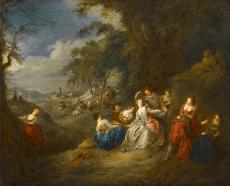


One of the many problems with Jean-Baptiste Pater’s oeuvre is the status of the many versions of his compositions. There seems little doubt that he did himself make both exact and variant replicas of his own works, but, with side-by-side comparison rarely possible, and with the various versions often in differing states of conservation, it can be by no means easy either to identify the prime version or to say which of the copies or variants are autograph.
In the case of the present composition, it has always been assumed that, being apparently signed, and with a history going back to Frederick the Great, it is the picture in Schloss Sanssouci that is the prime autograph version.The recent, very thorough technical and art-historical research into the painters of fêtes galantes in the palaces of Berlin-Brandenburghas not only pointed to what may be a superior version of the composition, in Helsinki,but that the apparently authentic signature is on an extension of the painted surface of the picture.It seems probable that this carrying over of the painting onto the unpainted border was not the work of Pater himself, but a later intervention, after one of its many reframings. That this is indeed the case is strongly supported by the fact that, when it was first recorded, by Matthias Oesterreich, in his catalogue of the paintings in Sanssouci, Potsdam and Charlottenburg, in 1773, it was ascribed to Nicolas Lancret (1690-1743).
Florence Ingersoll-Smouse, in her ground-breaking book on Pater, listed three other versions or variants of the present picture and a copy of it.The first is the picture in Sanssouci.A variant of this, which substitutes a man playing a flute and a young woman singing from a music book for the man forcing his attentions on a woman, behind the central figure of the woman in white (thus removing the cause of the woman in a blue dress starting back in alarm), is the picture at Kenwood House in London.Another version was in Reginald Vaile’s collection and sale.A picture cited by Ingersoll-Smouse as in the sale of the Freiherrn von Minnigerode-Alherberg in Berlin,as a copy of this, is now in the Art Institute of Chicago. This has the letters A. W. on the plinth of the sculpture, which, it has been suggested, are the initials of Prince August Wilhelm of Prussia as the copyist. Christoph Martin Vogtherr added the autograph version in Helsinki and three copies to this list, but also cited the present picture, as: ‘Jean-Baptiste Pater (?)…eigenhändige Version oder Kopie nach der version in Helsinki’ [autograph version or copy of the version in Helsinki].It seems probable that he only knew this from a photograph or annotated cutting from the catalogue of the 1964 sale (he does not mention the 1967 sale)1in the Service de Documentation in the Louvre; if so, his caution is understandable. Even now, it is difficult to know exactly what to make of the picture. It is smaller than the Sanssouci version, but roughly the same size as the one in Helsinki, whose background figures it repeats, rather than those of the Berlin picture. It is therefore in relation to that that it should be judged. When it and the illustration of the Helsinki picture in the Berlin catalogue are compared, the latter appears to be more finished in every particular. This is especially apparent in the trees and foliage, but the faces of the figures also seem slighter and more tentative. These would be unusual changes for a copyist to make, but they are compatible with the idea that this might be a first, and still sketchy, version of the composition. More work needs to be done on paintings ascribed to Pater, to see if there are others with the same characteristics that might demonstrate whether or not he did sometimes make semi-sketched first versions of his painted compositions.
A French Rococo painter and draughtsman, he was the son of a sculptor, Antoine Pater, and was briefly thestudent of Jean-Antoine Watteau, who influenced him considerably. His fêtes galantes imitated those ofWatteau, yet he developed his own distinct line. He was patronised by Frederick the Great.